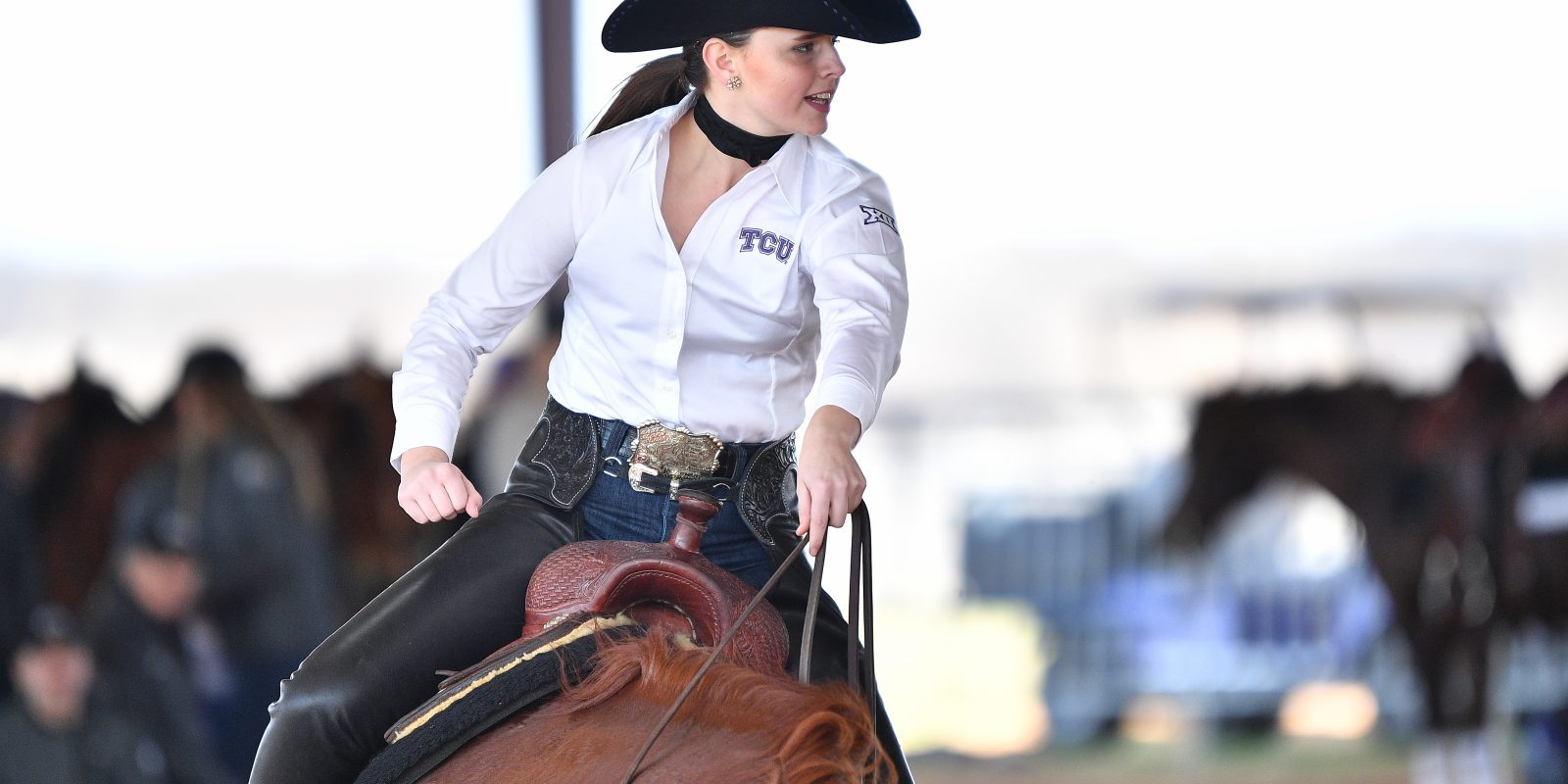
Equestrian Team Is Ready for Another Run
After back-to-back final four finishes, TCU saddles up for a new year.
On any given afternoon from late August to mid-April, a contrasting scene plays out at Turning Point Ranch in Springtown, Texas: Grazing show horses dot rolling green pastures while, inside a pair of covered arenas, the dirt, sweat and ponytails fly as student-athletes and their equine teammates perfect their competitive moves.
“You know what I like?” Haley Schoolfield, director of equestrian at TCU, asks a rider after she clears the last fence in an obstacle course of jumps. “You really fought for it the first time through. You helped him through it.”
Off to the side, one of the riders in the women’s equestrian program warms up Luna, a mare, for their practice session. The rider holds the end of a long lunge line as Luna circles around her with a rhythmic clop, clop, clop.
Another rider sits atop her mount, Java, in front of the judge’s stand, the perch where Logan Fiorentino, hunt seat head coach, keeps a keen eye on every detail and movement between horse and rider.
As coach and rider dissect her jaunt through the jumps, Java moans and groans. The horse knows his part in the course run-through was perfect and seems to wonder why he needs to go through the paces again.
Giggles echo as another equestrian rider bounds around the arena on the back of an unsettled Calisto, who is perfect six days out of seven but at the moment looks more like a rodeo bronco. The rider is all smiles as she eases the horse from a romp back into a smooth canter with encouragement from Schoolfield.
In the second covered arena, a half-dozen mounted Western riders form a semicircle around Melissa Dukes ’89 as they hang on to every word of wisdom. Dukes just finished her second season as Western head coach at TCU.
Two other riders lead their horses back to the barn, where the animals enjoy a thorough brushing, a warm shower and lots of affection before returning to the pasture or their stables. Scattered about the 36 stalls, riders are grooming horses, cleaning hooves or adjusting tack.
All across the 30-acre ranch, human and equine Horned Frogs are at various stages of practice, performance or cooldown. The work is structured and intense, but the faces of both student-athletes and equine-athletes reveal a love of the graceful sport.
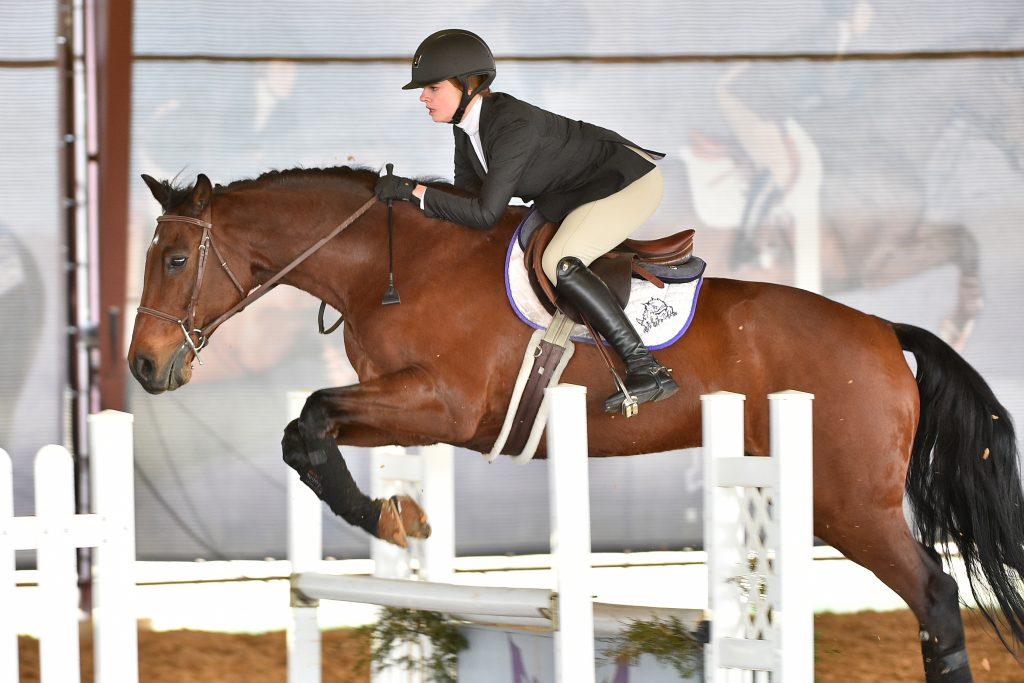
Molly Peddicord ’17 rode Tux in Equitation Over Fences as TCU, the home team, faced Fresno State in February 2016. Photo by TCU Athletics/Michael Clements
Going at a Gallop
Routines for the riders are similar for up to 144 days, the number of practice days the NCAA allots per year: breakfast, workout, class, lunch, 45-minute drive to the barn, one-hour practice, 45-minute drive back to campus, dinner, study, sleep, repeat.
The equestrian program is almost a year-round sport. It begins a week after school starts in August, wraps up before Thanksgiving, starts back with the first day of class in January and ends — ideally — with an invitation to the National Collegiate Equestrian Association’s national championship in April.
Between August and the national championship, per NCAA rules, a team can compete in up to 15 competitions, plus a conference championship.
“On paper we can use them for 20 hours a week,” Schoolfield said. “I don’t think we get over about 15 hours a week on paper, but it feels like much more than that. It feels like they are constantly on the go, and they are.”
It’s exhausting work, but the riders are quick to say they are living their dreams.
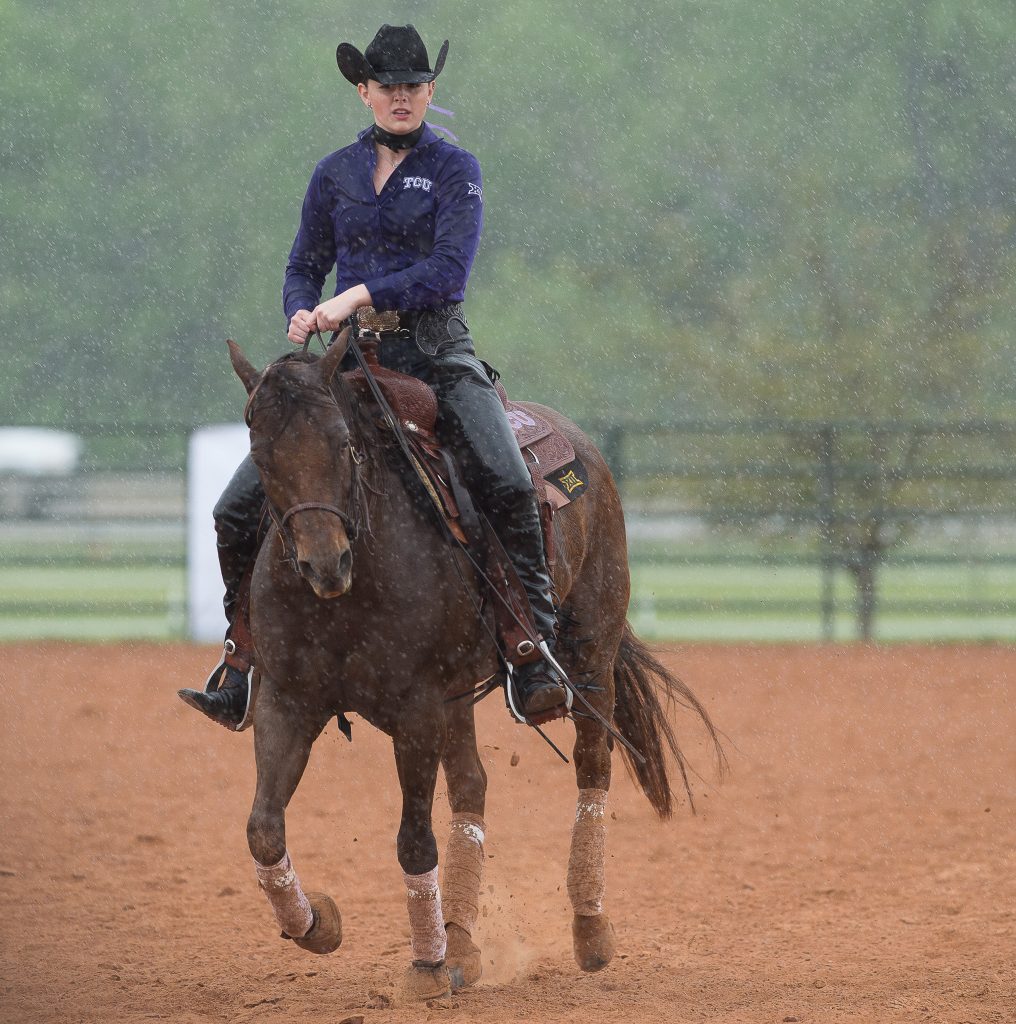
Carly Lombard didn’t let the rain dampen her Western Reining performance on Baylor horse Callie during round one of the Big 12 Championship in Waco, Texas, in March. Photo by Glen E. Ellman
“We have incredible student-athletes who work very, very hard for their success,” said Schoolfield, who was the 2016 NCEA Coach of the Year. “They are willing to practice rain, shine, hot, cold — whatever the condition, they are willing to push through it to get the practice in.”
The riders show that hard work pays off. In April 2017, TCU knocked out No. 1 seed Baylor to advance to the semifinals of the NCEA National Championship before falling to Texas A&M, which won the championship. It was the second year in a row that the Horned Frogs lost to the eventual champion. In 2016, they lost in the finals and ended the year ranked No. 2 in the nation, a program best.
“We made it to the final four for the second year in a row, which is something as a program we hadn’t done before. That’s definitely a positive and something to build on,” Fiorentino said. “Beating Baylor when Baylor was No. 1 was an exciting moment for us. We had some great rides.”
After more than a decade in the saddle, TCU’s equestrian team is blazing its trail. Coaches and riders hope to build on the success of the past two seasons and make the most of hosting the Big 12 Championship on March 30-31.
“It would be really awesome to win the Big 12 title at home in front of our home fans, friends and family,” Fiorentino said. “Obviously, winning a national championship is always on that goal list.”
“We ended the season on a high note beating Baylor, but then again I think everyone is going to come back hungry for more,” said Jada Taylor, a junior strategic communication major from Washington, D.C.
Trotting out the Sport
The NCAA and the Committee on Women’s Athletics adopted equestrian competition as an emerging sport for women in 1998, and the National Collegiate Equestrian Association was created to advance the sport. In NCAA Division I, there are 17 equestrian programs.
Leah Holland Fiorentino, executive director of the national association (and mom of TCU’s Fiorentino), is optimistic that the number of collegiate programs will grow.
“We think schools are interested in adding equestrian [programs] because of the strong caliber of student-athletes that comprise equestrian teams,” she said.
With its Fort Worth roots, TCU is a natural fit for equestrian sports, Schoolfield said. “TCU is in the heart of horse country. Fort Worth is home to many national and world championship shows. There are many riders, trainers and potential student-athletes who, when they think of a great place for equestrian competition, they think of Fort Worth.”
TCU’s equestrian program began in 2006 with 18 student-athletes. With 42 riders this season, it is the second-largest team on campus, behind football, which has about 120 players.

Riders and their horses leave another day of practice at the TCU practice facility in Springtown, Texas. From left are Melissa Dukes ’89, Megan McMullen ’17, Rylee Morgan ’17 with Bob, Josie Mootz with Shy, Jamie Cook with Cupid, Marah Huston with Jackson and Laska Anderson with Jack. Photo by Glen E. Ellman
“It has come so, so far,” said Schoolfield, who served as an assistant coach from 2007 to 2009 and returned as head coach in 2013. “In the beginning days, we had to borrow and lease horses to make things work. Now we have around 40 horses, a beautiful facility and good equipment. We’ve come so far in the 10 years. It’s night and day.”
High Spirits
One of the things that sets TCU’s equestrian program apart is the camaraderie. Kari Hancock ’17 of Anchorage, Alaska, credits the 45-minute shared commutes for practice, the coaches’ team-building efforts and the type of student-athlete the university recruits.
“TCU is known as a friendly, open, welcoming school. We’re very supportive and we really try to help each other out as much as possible,” said Hancock, who was a Chancellor’s Scholar in the John V. Roach Honors College. She graduated summa cum laude with a bachelor’s degree in biochemistry.
“We want to do our best for the rest of the team. We are cheering each other on and being as loud as possible, doing everything we can to help out whoever is in the ring at that moment,” said Hancock, who now attends veterinary school in California. “We have a huge cheering section, and we know how to yell.”
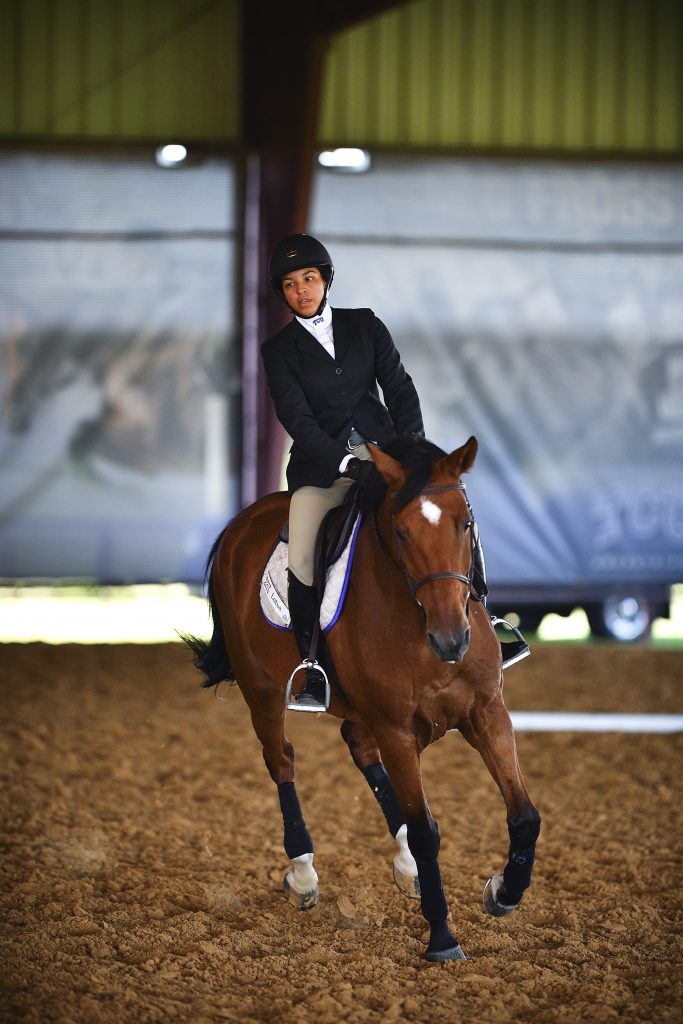
Jada Taylor of Washington, D.C., rode Lotus in Equitation on the Flat against Texas Tech at TCU’s Turning Point Ranch in Springtown, Texas, in September 2016. Taylor said the riders treat their horses as teammates. Photo by TCU Athletics/Michael Clements
Sometimes the team and its fans holler too well. Frogs cheering on Frogs at the Big 12 Championship got so loud that the announcer paused and asked the crowd to rein in the noise.
“As a coach, I really enjoy getting to see the teammates out there pulling for each other physically, emotionally and spiritually,” Fiorentino said. “That energy they create really is contagious. And it’s pure. I think that’s what sets us apart a little bit from other programs is the girls really do ride for each other. They bleed for each other, they sweat for each other, and they really display that at championships.”
Not even disappointing results muffle the cheers. At the national championship semifinals, Frogs were still going wild when Texas A&M was up 15-0.
“We got absolutely slaughtered,” said Laska Anderson of Leitchfield, Kentucky, who competes in Western Horsemanship. “Our last girl went, and the best hope we had was getting just a single point on the board. After her ride, everybody in our section stood up and screamed and jumped and clapped like we had just won.
“The other teams looked at us like we were crazy,” said Anderson, a sophomore history and English major in the John V. Roach Honors College. “She didn’t get her point, and we still didn’t get a point on the board, but that was OK — we still supported each other.”
Half-ton Teammates
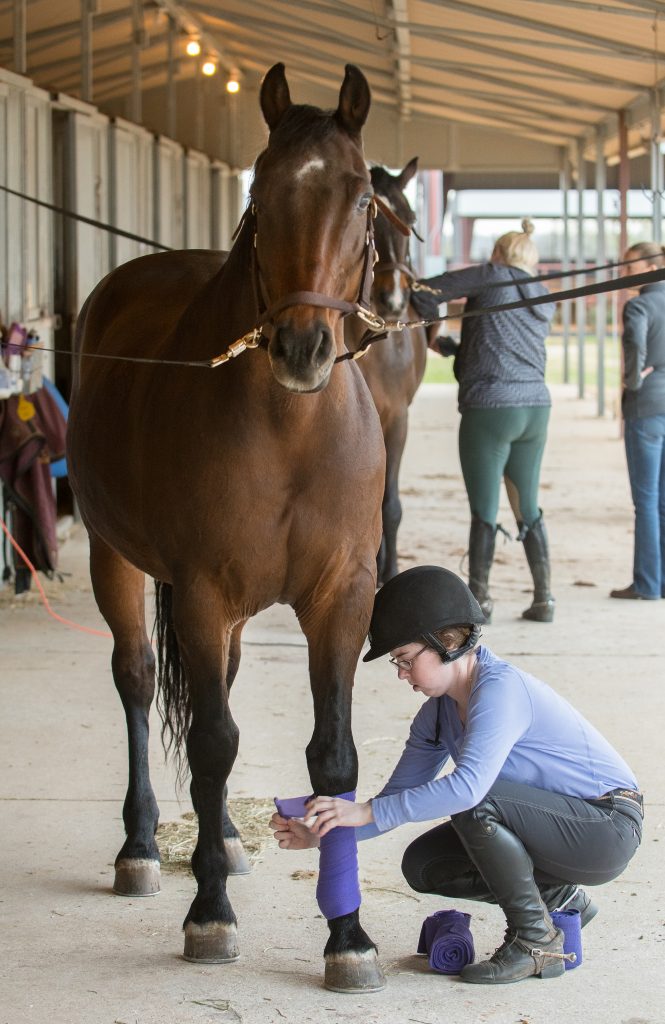
Julia Finn wraps the legs of Tux, one of TCU’s horses, at the equestrian practice facility. The riders become attuned to the moods of their horses. Photo by Glen E. Ellman
Unlike other collegiate sports, equestrian riders must rely on the cooperation of a 1,000- to 1,200-pound equine teammate that has its own needs, likes, dislikes and quirks.
“There’s so much we do that goes into taking care of the horses — not just practicing and riding,” said Anderson. “They’re not like footballs where you just air them up now and then. We are each assigned a horse that we bathe and make sure they have all their medicines and make sure they’re healthy and happy and clean. So there’s just a lot that goes into the side that you don’t really see.”
“With other teams, if you pop a ball, you go out and get a new one. For us, it’s completely different,” said Molly Peddicord ’17 of Malibu, California, who competed in both hunt seat events. “We would have to patch that ball back up and make that ball work again.
“It’s also different in college because you ride random horses all the time when going to other schools. I love riding horses because of the connection with the horse,” said Peddicord, who graduated with a bachelor’s degree in communication studies. “In college I learned how to make a connection in the four minutes of warmup time, and I learned how to get along with a lot of different types of horses.”
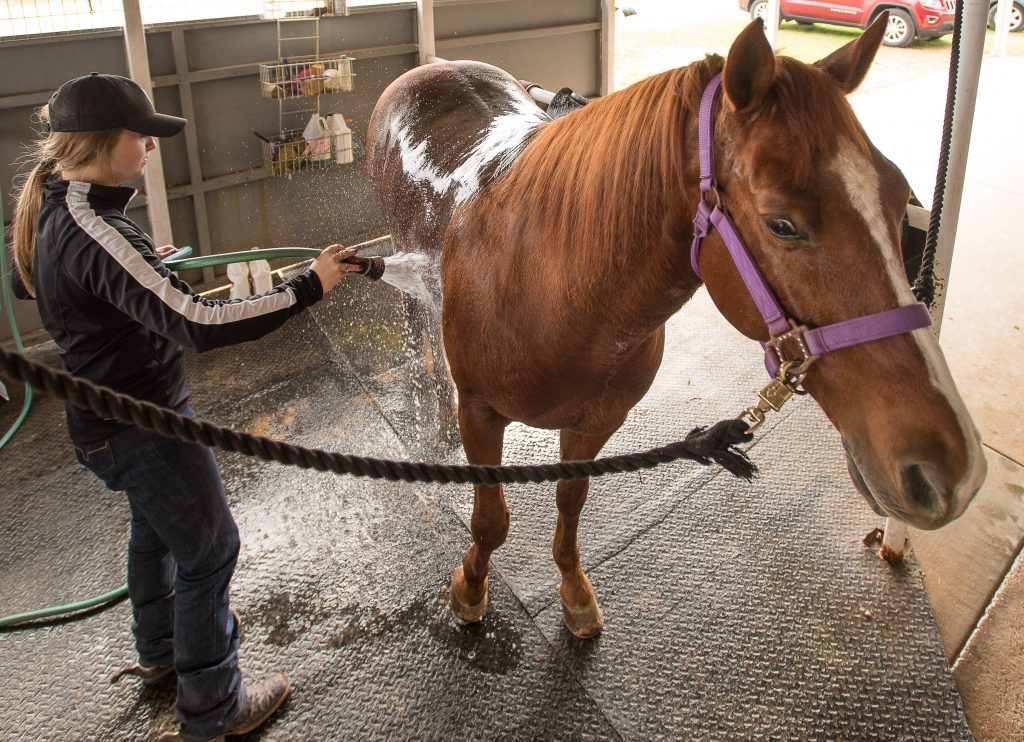
Western rider Rylee Morgan ’17 washes Bob after practice. The student-athletes are assigned a horse or two to bathe and help care for. Photo by Glen E. Ellman
Hancock said the horses have minds of their own, and “they weigh a heck of a lot more than you. If they don’t want to do something, they don’t have to do it,” she said. “There is kind of a very subtle, secret language between a horse and rider that’s more through touch, body weight and to some extent voice — they do listen to vocal cues.
“And they can feel your energy. So if you’re calm, they’re calm. It’s a mental game,” Hancock said. “That’s what the equestrian sport is. It’s all about what’s in your head and being able to transmit that through your body to the horse.”
Pacing Themselves
As with many other student-athletes, the biggest challenge for equestrian competitors is juggling all the responsibilities of participating in a competitive sport and studying for academic achievement.
“It can be really overwhelming balancing your academics with the workouts, practices and our meets,” Taylor said. “I had to learn coming in as a freshman to stay organized and not leave things to the last minute.
“I definitely learned — I’m going to say the hard way — not to leave my big papers or big projects until the night before because obviously I’m going to be tired from workouts and practice.”
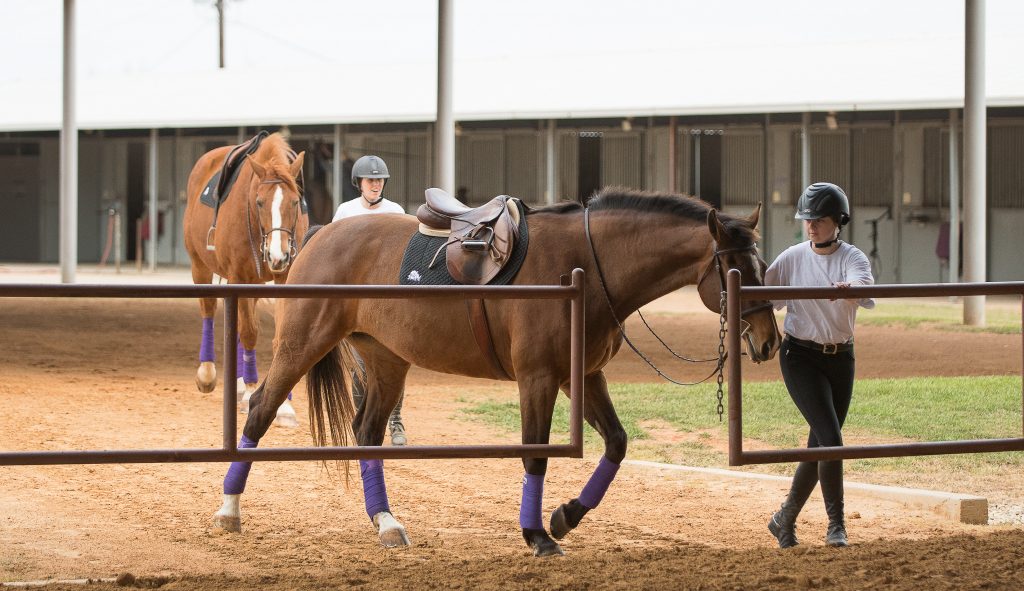
Molly Peddicord ’17 leads Tony, followed by Carley Barnett with Phia, as they head into the TCU practice ring. Photo by Glen E. Ellman
For the equestrian team, accountability to other riders, support from the athletics staff and understanding from professors help achieve positive outcomes.
“I’ve learned throughout the past four years that just talking to my professors — especially at TCU, where the professors know you by name — really helps,” said Peddicord, who was TCU’s first student-athlete to be named an All-American in two disciplines in the same year.
Peddicord was named a 2016 NCEA First-Team All-American in Equitation Over Fences and NCEA Honorable Mention All-American in Equitation on the Flat.
“It’s a lot of planning and just staying on top of everything because as soon as you fall behind, it’s a mess,” Peddicord said. “It’s a huge accomplishment to be able to say I was a student-athlete at a university as academically competitive as TCU.
“A lot of all-nighters were pulled. For sure it’s not easy, but by far it’s one of the most worth-it things that I’ve ever had to work so hard for.”

Your comments are welcome
1 Comment
Fabulous to read the stories And triumphs with the TCU equestrian team. Keep up the great work, my oldest daughter was a horn Frog and my other two because of the fabulous equestrian team are seriously considering attending TCU for the equestrian team as well as all of the other incredible opportunities TCU offers. Keep riding everyone!!
Brenda
Related reading:
Features
TCU Horses Bring Personalities to Competitions
Not just a horse, of course – equine-athletes are the stars of the stable at equestrian events.
Features
How Equestrian Competition Works
Horseplay: Game Day Logistics. TCU and other schools face off for points in four equestrian events.
Features, Sports: Riff Ram
TCU Equestrian Competitors Ride High in Academic Accolades
Student-athletes keep a tight rein on their academic studies.